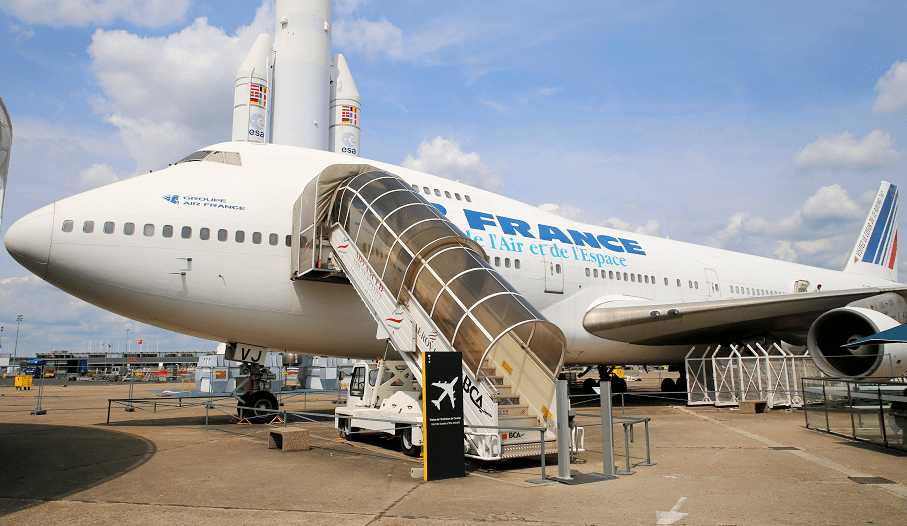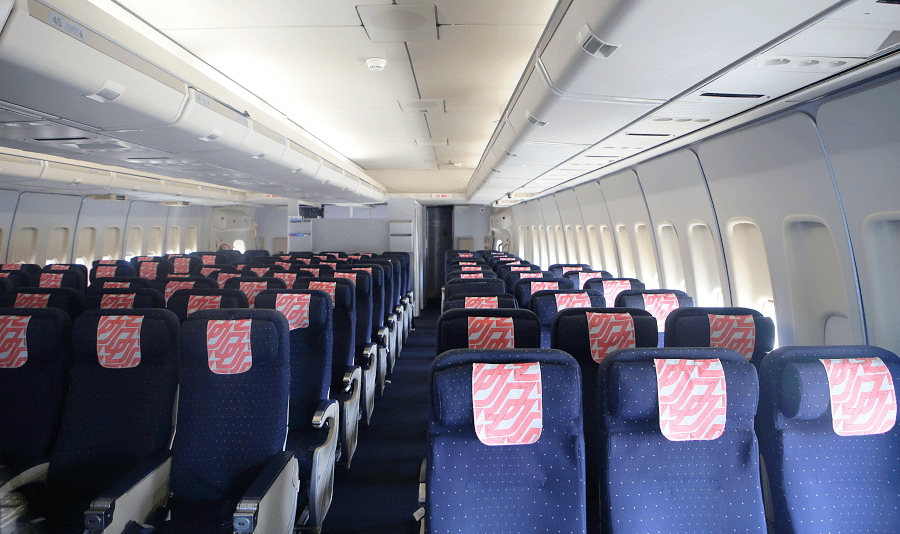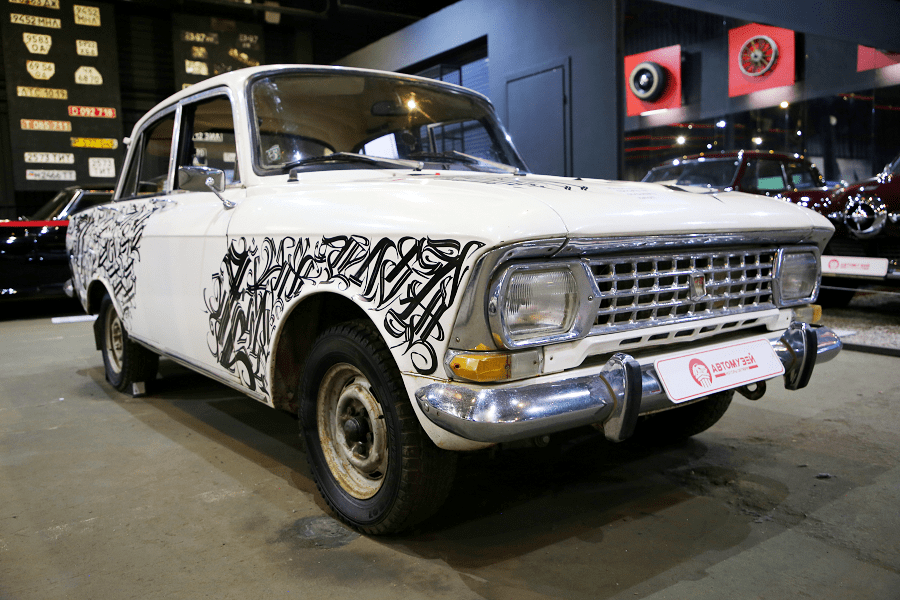Boeing 747

Boeing 747-128 (F-BPVJ). Le Bourget Museum (Paris, France)
The Boeing 747 is a large, long-range wide-body airliner designed and manufactured by Boeing Commercial Airplanes in the United States between 1968 and 2023. After introducing the 707 in October 1958, Pan Am wanted a jet 2+1⁄2 times its size, to reduce its seat cost by 30%. In 1965, Joe Sutter left the 737 development program to design the 747. In April 1966, Pan Am ordered 25 Boeing 747-100 aircraft, and in late 1966, Pratt & Whitney agreed to develop the JT9D engine, a high-bypass turbofan. On September 30, 1968, the first 747 was rolled out of the custom-built Everett Plant, the world’s largest building by volume. The first flight took place on February 9, 1969, and the 747 was certified in December of that year. It entered service with Pan Am on January 22, 1970. The 747 was the first airplane called a “Jumbo Jet” as the first wide-body airliner.
The 747 is a four-engined jet aircraft, initially powered by Pratt & Whitney JT9D turbofan engines, then General Electric CF6 and Rolls-Royce RB211 engines for the original variants. With a ten-abreast economy seating, it typically accommodates 366 passengers in three travel classes. It has a pronounced 37.5° wing sweep, allowing a Mach 0.85 (490 kn; 900 km/h) cruise speed, and its heavy weight is supported by four main landing gear legs, each with a four-wheel bogie. The partial double-deck aircraft was designed with a raised cockpit so it could be converted to a freighter airplane by installing a front cargo door, as it was initially thought that it would eventually be superseded by supersonic transports.
Boeing introduced the -200 in 1971, with more powerful engines for a heavier maximum takeoff weight (MTOW) of 833,000 pounds (378 t) from the initial 735,000 pounds (333 t), increasing the maximum range from 4,620 to 6,560 nautical miles (8,560 to 12,150 km; 5,320 to 7,550 mi). It was shortened for the longer-range 747SP in 1976, and the 747-300 followed in 1983 with a stretched upper deck for up to 400 seats in three classes.
The heavier 747-400 with improved RB211 and CF6 engines or the new PW4000 engine (the JT9D successor), and a two-crew glass cockpit, was introduced in 1989 and is the most common variant. After several studies, the stretched 747-8 was launched on November 14, 2005, with new General Electric GEnx engines, and was first delivered in October 2011. The 747 is the basis for several government and military variants, such as the VC-25 (Air Force One), E-4 Emergency Airborne Command Post, Shuttle Carrier Aircraft, and some experimental testbeds such as the YAL-1 and SOFIA airborne observatory.
Initial competition came from the smaller trijet widebodies: the Lockheed L-1011 (introduced in 1972), McDonnell Douglas DC-10 (1971) and later MD-11 (1990). Airbus competed with later variants with the heaviest versions of the A340 until surpassing the 747 in size with the A380, delivered between 2007 and 2021. Freighter variants of the 747 remain popular with cargo airlines. The final 747 was delivered to Atlas Air in January 2023 after a 54-year production run, with 1,574 aircraft built. As of January 2023, 64 Boeing 747s (4.1%) have been lost in accidents and incidents, in which a total of 3,746 people have died.
Operational history
After the aircraft’s introduction with Pan Am, other airlines that had bought the 747 to stay competitive began to put their own 747s into service. Boeing estimated that half of the early 747 sales were to airlines desiring the aircraft’s long range rather than its payload capacity. While the 747 had the lowest potential operating cost per seat, this could only be achieved when the aircraft was fully loaded; costs per seat increased rapidly as occupancy declined. A moderately loaded 747, one with only 70 percent of its seats occupied, used more than 95 percent of the fuel needed by a fully occupied 747. Nonetheless, many flag-carriers purchased the 747 due to its prestige “even if it made no sense economically” to operate. During the 1970s and 1980s, over 30 regularly scheduled 747s could often be seen at John F. Kennedy International Airport.
The recession of 1969–1970, despite having been characterized as relatively mild, greatly affected Boeing. For the year and a half after September 1970, it only sold two 747s in the world, both to Irish flag carrier Aer Lingus. No 747s were sold to any American carrier for almost three years.
When economic problems in the US and other countries after the 1973 oil crisis led to reduced passenger traffic, several airlines found they did not have enough passengers to fly the 747 economically, and they replaced them with the smaller and recently introduced McDonnell Douglas DC-10 and Lockheed L-1011 TriStar trijet wide bodies (and later the 767 and A300/A310 twinjets). Having tried replacing coach seats on its 747s with piano bars in an attempt to attract more customers, American Airlines eventually relegated its 747s to cargo service and in 1983 exchanged them with Pan Am for smaller aircraft; Delta Air Lines also removed its 747s from service after several years. Later, Delta acquired 747s again in 2008 as part of its merger with Northwest Airlines, although it retired the Boeing 747-400 fleet in December 2017.
International flights bypassing traditional hub airports and landing at smaller cities became more common throughout the 1980s, thus eroding the 747’s original market. Many international carriers continued to use the 747 on Pacific routes. In Japan, 747s on domestic routes were configured to carry nearly the maximum passenger capacity.
Country: USA
First flight: February 9, 1969
Years of production: 1968–2023
Production: 1,574 planes (all modifications)
Crew: 3 (captain, first officer, flight engineer)
Capacity (passengers): 480 (747-100) / 660 (747-400)
Length: 70.7 m (231 ft 10 in)
Wingspan: 59,64 m (195 ft 8 in)
Height: 19.33 m (63 ft 5 in)
Engine: 4 × Pratt & Whitney JT9D
Max speed: 939 km/h
Range: 8,560 km (5,320 mi; 4,620 nmi)
Ceiling: 13,747 m (45,100 ft)
Empty weight: 162,386 kg (358,000 lb)



















